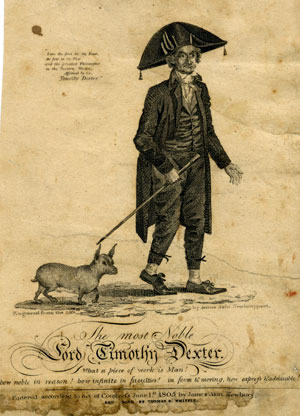From “The Strange Life of ‘Lord’ Timothy Dexter,” a very amusing Priceonomics post by Zachary Crockett about America’s first eccentric on note, an illiterate and foolhardy man who fell ass backwards into vast wealth, which, along with a bogus title, could gain him no respectability:
A Princely Estate
Newburyport, in the late 1700s, was a supposedly idyllic town — a place where “rich and poor mingled”, and where the “population was not so large as to hide any individual, however odd or humble.” Though possessing only one of these traits, Timothy Dexter wasted no time in taking advantage of his arrival.
With his new fortune, Dexter purchased a healthy fleet of shipping vessels, a stable of brilliant cream colored horses, and a lavish coach adorned with his initials. Then, in grand fashion, he erected a “princely chateau” overlooking the sea — a chateau, it should be noted, that included the most lavish furnishings on the market, right down to its “tasteful and commodious outhouses.”
As recounted by a 19th century historian, Dexter then hired the “most intelligent and tasteful” artists of European architecture to carve and mount a series of more than 40 giant, wooden statues on his property, each depicting a great character in American lore:
“…The tasteless owner, in his rage for notoriety, created rows of columns, fifteen high feet at least, on which to place colossal [statues] carved in wood. Directly in front of the door of the house, on a Roman arch of great beauty and taste, stood general Washington in his military garb. On his left was Jefferson; on his right, Adams. On the columns in the garden there were figures of indian chiefs, military generals, philosophers politicians, statesmen…and the goddesses of Fame and Liberty.”
Not to be outshined, Dexter then erected a final statue — one of himself. Beneath it, he boastfully painted an inscription — “I am the first in the East, the first in the West, and the greatest philosopher in the Western world” — this, coming from a man who’d neither contributed anything to the field of Philosophy nor ever read a single book on the subject.At $2,000 a piece, the 40 statues cost Dexter twice as much as he’d paid for his entire estate — but with them, the outcast achieved his ultimate aim: to garner the public’s attention. “It made the bumpkins stare,” writes Samuel L. Knapp, “and gave the owner the greatest pleasure.”
In time, Dexter began to garner to wrong kind of attention. His estate became so much of an aesthetic embarrassment that his wife soon abandoned ship to live elsewhere in the neighborhood; in her absence, Dexter’s son — a morose lad who, like his father, took no joy in learning — moved in. In short order, the home was turned into a “bagnio” (brothel) of sorts: long nights of drunken buffoonery ensued, in which women came and went, and the fine interiors (including curtains once owned by the Queen of France) were soon covered in “unseemly stains, offensive to sight and smell.”•

